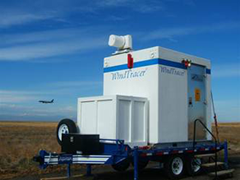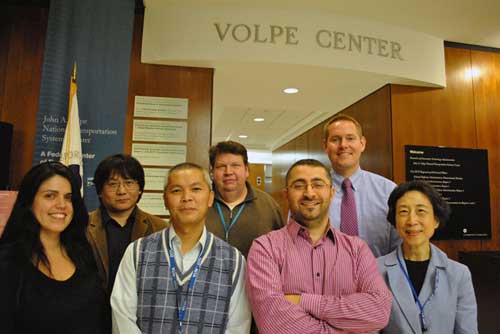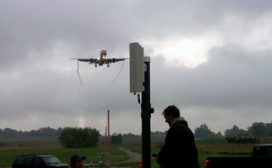Wake Turbulence Research: An Esoteric Field of Study That Pays Big Dividends
The findings from a decade of wake turbulence research are helping reduce airport delays, shorten final approaches to airports, and reduce fuel burn and emissions. Wake turbulence, the movement of air created by an aircraft in motion, may be an esoteric field of study, but the body of knowledge from this field of research has enabled the Federal Aviation Administration (FAA) to make operational changes in the National Airspace System (NAS), allowing for smaller minimum aircraft separation distances in some situations and increased rates of takeoffs and landings on runways.
Technical staff at Volpe, The National Transportation Systems Center, have been intimately involved in wake turbulence research for nearly 40 years. Volpe experts, along with scientists and engineers from FAA, the National Astronautics and Space Administration (NASA), sensor manufacturers, Eurocontrol, and many other organizations, have improved the methods, sensor technologies, and data processing and analysis techniques for measuring wake turbulence. These improvements have provided a greater degree of fidelity in the characterization of wake turbulence, thereby increasing confidence in the measured results and its associated safety assessment processes.
Encountering wake turbulence disrupts the aerodynamic properties of aircraft, similar to the way wakes created by ships affect other vessels. Like wakes on the water, aircraft wakes dissipate over time and space. When an aircraft proceeds along a runway for takeoff or completes its airport approach and lands, air traffic controllers must allow the wake turbulence created by that aircraft to dissipate or move away from the flight path before other aircraft takeoff or land. Generally, the larger the size of an aircraft, the greater the amount of wake turbulence and the longer the time that is required for the wake to dissipate. Understanding how wake turbulence dissipates over time and space and also understanding how it is affected by winds and other environmental factors is essential for determining aircraft separation standards and the time delay required between successive takeoffs and landings.
The implementation of operational changes based on scientific exploration is a success story for the wake turbulence research community. As a federal organization, Volpe not only conducts quality wake turbulence research, it collaborates with operators and policy makers—in this case, air traffic controllers, pilot groups, and FAA headquarters offices—to help implement research results.
Three changes in the way operations are conducted highlight the benefits of this seemingly esoteric field of study:
Recategorization

Based on the improved understanding of wake turbulence dynamics, the FAA has made several operational changes that increase the capacity of the NAS. Beginning at Memphis International Airport (MEM), new separation standards that allow reduced spacing between aircraft are being used. Referred to as "wake turbulence recategorization," the FAA has moved from a separation distance based primarily on aircraft weight, to one that also incorporates several aircraft design characteristics. This will allow more aircraft to takeoff and land per hour at this busy FedEx hub.
Wake Turbulence Mitigation for Departures (WTMD)

Through various field experiments, scientists and engineers have refined their understanding of how winds interact with wakes and affect wake dissipation. This improved understanding has been especially important for airports with closely spaced parallel runways: runways separated by less than 2,500 feet. Upwind parallel runways are now known to be affected less by wakes generated by aircraft departing from downwind parallel runways. To take advantage of this insight, three airports—Houston (IAH), Memphis (MEM), and San Francisco (SFO)—are currently installing a system that monitors the actual and predicated wind at that airport. When conditions are within a prescribed safety margin, the WTMD system informs the air traffic operation that a specific runway use can be accomplished free from wake constraints.
Parallel Runways

The Technology Behind Recent Wake Turbulence Measurements
 The technologies used to conduct wake turbulence measurements are state-of-the-art and complex, as one might expect. Pulsed LIDARs in the infrared range have become the preferred technology. (LIDAR is an acronym for light detection and ranging.) These devices emit short pulses of laser light that interact with microscopic particles in the atmosphere. The atmospheric particles cause the laser light to scatter, and a portion of this light is scattered back toward the LIDAR. The back-scattered light that reaches the LIDAR provides information on wind velocity and direction. Each pulse, through the same time-of-flight operating principle used in the radar tracking of vehicles on roadways, provides data about the location of the particle that caused the backscatter. Since these atmospheric particles faithfully follow the wind field, pulsed LIDAR directed at an aircraft's wake provides the detailed information on the movement of these microscopic particles in and around the wake. Technical staff uses this information to reconstruct the features of the aircraft wake vortices.
The technologies used to conduct wake turbulence measurements are state-of-the-art and complex, as one might expect. Pulsed LIDARs in the infrared range have become the preferred technology. (LIDAR is an acronym for light detection and ranging.) These devices emit short pulses of laser light that interact with microscopic particles in the atmosphere. The atmospheric particles cause the laser light to scatter, and a portion of this light is scattered back toward the LIDAR. The back-scattered light that reaches the LIDAR provides information on wind velocity and direction. Each pulse, through the same time-of-flight operating principle used in the radar tracking of vehicles on roadways, provides data about the location of the particle that caused the backscatter. Since these atmospheric particles faithfully follow the wind field, pulsed LIDAR directed at an aircraft's wake provides the detailed information on the movement of these microscopic particles in and around the wake. Technical staff uses this information to reconstruct the features of the aircraft wake vortices.A light detection and ranging (LIDAR) system used to measure atmospheric particles in motion. (Volpe photo)
Meet the Team

Says Dr. Frank Wang, Volpe principal technical advisor in wake vortices and team leader, "In the past decade, wake turbulence research has started to yield significant operational benefits in terms of airspace capacity. My biggest accomplishment is to be a part of the R&D team that is responsible for such improvements."
Above: Members of the wake turbulence team. From left to right: Melanie Soares, Frank Wang, Khang Nguyen, Tim Hall, Hadi Wassaf, Steve Mackey, and Suzanne Chen.
Team members not pictured: Zale Anis, Donna Burke, Steven Lang, Jayne Rossetti, Paul Slaboch, Constantine Speridakos, Chris Tracy, and Yan Zhang.

